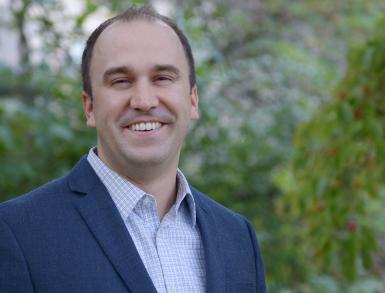Journalism transparency event pilots community engagement-based research
One of the most commonly discussed values of journalism during the last few years is transparency — the concept that consumers, for the most part, want to have a clear understanding of both the information presented to them and the journalists presenting the information.

But according to a report published by the Pew Center last month, only about 21 percent of United States adults have spoken with a local journalist.
Saturday, Media School assistant professor Jason Peifer tried to make the journalist-reader relationship less opaque with Making the News: A Community Conversation, an event in Bedford. Featuring local journalists and media experts, the event tested whether the tactic of showing glimpses of the journalism process and expanding journalism-reader engagement can lead to a stronger understanding of and trust in journalism.
“Many people might have a vague idea of how journalists carry out their work, perhaps based on what they see on TV or in movies, but for many, their understanding is somewhat limited,” Peifer said. “Many people have never even met a journalist, or if they have, any personal interaction has been pretty limited.”
The event was funded by a $25,000 Public Humanities Project grant from IU’s Arts and Humanities Council.
The full-day event began with a panel discussion about editing and managing news, moderated by Media School senior lecturer Teresa White. Panelists included WFIU/WTIU news bureau chief Sara Wittmeyer and IU student media director Jim Rodenbush.
The next session, moderated by Media School professor of practice Elaine Monaghan, dealt with reporting the news. Panelists included WTIU researcher Cathy Knapp and freelance correspondent Teri Schultz.
A panel about news investigations moderated by Media School associate professor Gerry Lanosga followed. Panelists included WTHR producer Susan Batt, FOX59 reporter Russ McQuaid and Media School visiting professor of practice Kathleen Johnston.
Attendees will be asked to fill out a followup survey. Those who couldn’t attend may also fill out an online survey.
Peifer will analyze the survey data to research the effectiveness of the program.
Peifer said about 30 community members attended the event, a number Peifer said allowed for discourse between the attendees and journalists.
“Participants weren’t an anonymous face in the masses,” Peifer said.
Peifer said he chose Bedford as the location for this event because he believed it is “representative” of multiple rural areas and small towns in Indiana, among other reasons.
“We wanted to get outside the confines of Bloomington, which is a fairly unique town within the scope of Indiana,” Peifer said.
And he said he’s happy with that decision. The community members who participated were friendly and engaged, and asked sharp questions, he said. They seemed to be enthusiastic about the value of a program like this that attempts to bring more transparency to a journalist’s audience.
“In many respects, this Bedford event was a pilot effort,” Peifer said. “It was a test run of a unique community engagement-based research effort and, in my view, it was absolutely worth the time and resources. It was an encouraging learning experience for myself and those who are working with me.”

